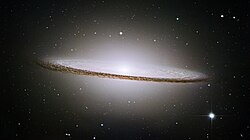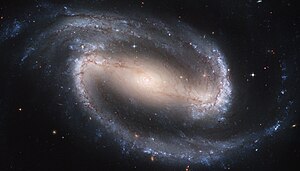Galaxies come in three main types: ellipticals, spirals, and irregulars. A slightly more extensive description of galaxy types based on their appearance is given by the Hubble sequence. Since the Hubble sequence is entirely based upon visual morphological type, it may miss certain important characteristics of galaxies such as star formation rate (in starburst galaxies) or activity in the core (in active galaxies).[6]
Ellipticals
The Hubble classification system rates elliptical galaxies on the basis of their ellipticity, ranging from E0, being nearly spherical, up to E7, which is highly elongated. These galaxies have an ellipsoidal profile, giving them an elliptical appearance regardless of the viewing angle. Their appearance shows little structure and they typically have relatively little interstellar matter. Consequently these galaxies also have a low portion of open clusters and a reduced rate of new star formation. Instead the galaxy is dominated by generally older, more evolved stars that are orbiting the common center of gravity in random directions. In this sense they have some similarity to the much smaller globular clusters.[28]
The largest galaxies are giant ellipticals. Many elliptical galaxies are believed to form due to the interaction of galaxies, resulting in a collision and merger. They can grow to enormous sizes (compared to spiral galaxies, for example), and giant elliptical galaxies are often found near the core of large galaxy clusters.[29] Starburst galaxies are the result of such a galactic collision that can result in the formation of an elliptical galaxy.[28]
Spirals

Spiral galaxies consist of a rotating disk of stars and interstellar medium, along with a central bulge of generally older stars. Extending outward from the bulge are relatively bright arms. In the Hubble classification scheme, spiral galaxies are listed as type S, followed by a letter (a, b, or c) that indicates the degree of tightness of the spiral arms and the size of the central bulge. An Sa galaxy has tightly wound, poorly-defined arms and possesses a relatively large core region. At the other extreme, an Sc galaxy has open, well-defined arms and a small core region.[30]
In spiral galaxies, the spiral arms have the shape of approximate logarithmic spirals, a pattern that can be theoretically shown to result from a disturbance in a uniformly rotating mass of stars. Like the stars, the spiral arms also rotate around the center, but they do so with constant angular velocity. That means that stars pass in and out of spiral arms, with stars near the galactic core orbiting faster than the arms are moving while stars near the outer parts of the galaxy typically orbit more slowly than the arms. The spiral arms are thought to be areas of high density matter, or "density waves". As stars move through an arm, the space velocity of each stellar system is modified by the gravitational force of the higher density. (The velocity returns to normal after the stars depart on the other side of the arm.) This effect is akin to a "wave" of slowdowns moving along a highway full of moving cars. The arms are visible because the high density facilitates star formation, and therefore they harbor many bright and young stars.

A majority of spiral galaxies have a linear, bar-shaped band of stars that extends outward to either side of the core, then merges into the spiral arm structure.[31] In the Hubble classification scheme, these are designated by an SB, followed by a lower-case letter (a, b or c) that indicates the form of the spiral arms (in the same manner as the categorization of normal spiral galaxies). Bars are thought to be temporary structures that can occur as a result of a density wave radiating outward from the core, or else due to a tidal interaction with another galaxy.[32] Many barred spiral galaxies are active, possibly as a result of gas being channeled into the core along the arms.[33]
Our own galaxy, the Milky Way, sometimes simply called the Galaxy (with uppercase), is a large disk-shaped barred-spiral galaxy[34] about 30 kiloparsecs in diameter and a kiloparsec in thickness. It contains about two hundred billion (2×1011)[35] stars and has a total mass of about six hundred billion (6×1011) times the mass of the Sun.[36]
Other morphologies

Peculiar galaxies are galactic formations that develop unusual properties due to tidal interactions with other galaxies. An example of this is the ring galaxy, which possesses a ring-like structure of stars and interstellar medium surrounding a bare core. A ring galaxy is thought to occur when a smaller galaxy passes through the core of a spiral galaxy.[37] Such an event may have affected the Andromeda Galaxy, as it displays a multi-ring-like structure when viewed in infrared radiation.[38]
A lenticular galaxy is an intermediate form that has properties of both elliptical and spiral galaxies. These are categorized as Hubble type S0, and they possess ill-defined spiral arms with an elliptical halo of stars.[39] (Barred lenticular galaxies receive Hubble classification SB0.)

In addition to the classifications mentioned above, there are a number of galaxies that can not be readily classified into an elliptical or spiral morphology. These are categorized as irregular galaxies. An Irr-I galaxy has some structure but does not align cleanly with the Hubble classification scheme. Irr-II galaxies do not possess any structure that resembles a Hubble classification, and may have been disrupted.[40] Nearby examples of (dwarf) irregular galaxies include the Magellanic Clouds.
Dwarfs
Despite the prominence of large elliptical and spiral galaxies, most galaxies in the universe appear to be dwarf galaxies. These tiny galaxies are about one hundredth the size of the Milky Way, containing only a few billion stars. Ultra-compact dwarf galaxies have recently been discovered that are only 100 parsecs across.[41]
Many dwarf galaxies may orbit a single larger galaxy; the Milky Way has at least a dozen such satellites, with an estimated 300–500 yet to be discovered.[42] Dwarf galaxies may also be classified as elliptical, spiral, or irregular. Since small dwarf ellipticals bear little resemblance to large ellipticals, they are often called dwarf spheroidal galaxies instead.
Tidak ada komentar:
Posting Komentar